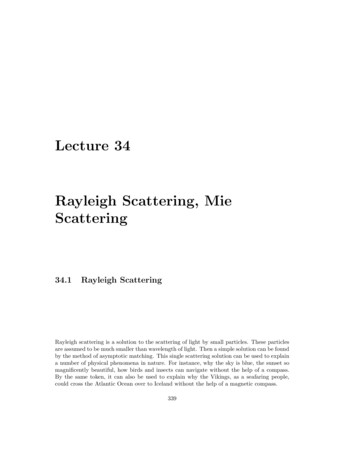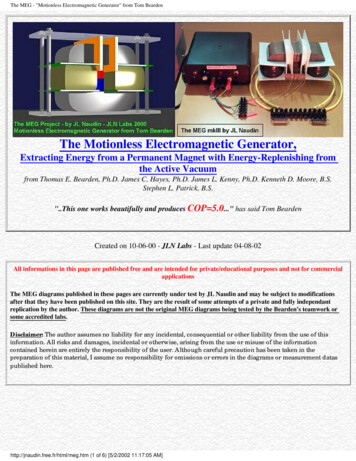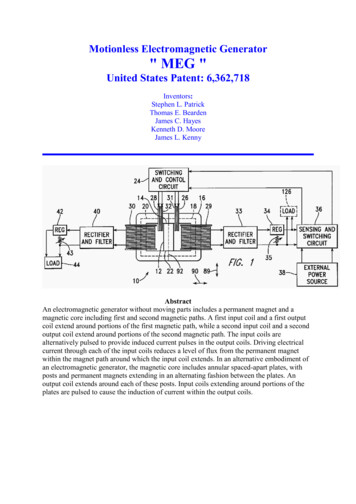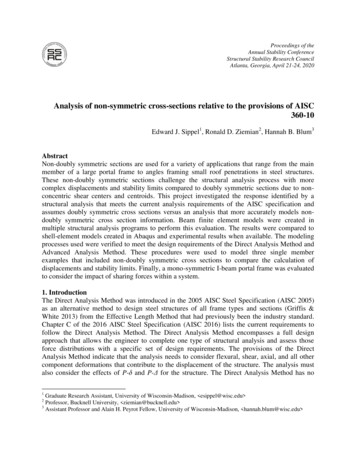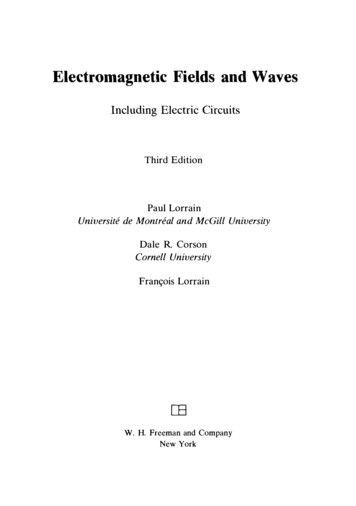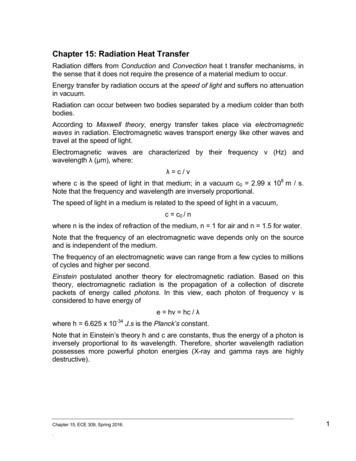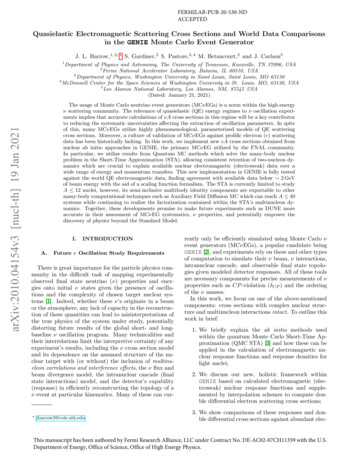
Transcription
FERMILAB-PUB-20-530-NDACCEPTEDQuasielastic Electromagnetic Scattering Cross Sections and World Data Comparisonsin the GENIE Monte Carlo Event GeneratorJ. L. Barrow,1, 2, S. Gardiner,2 S. Pastore,3, 4 M. Betancourt,2 and J. Carlson51arXiv:2010.04154v3 [nucl-th] 19 Jan 2021Department of Physics and Astronomy, The University of Tennessee, Knoxville, TN 37996, USA2Fermi National Accelerator Laboratory, Batavia, IL 60510, USA3Department of Physics, Washington University in Saint Louis, Saint Louis, MO 631304McDonnell Center for the Space Sciences at Washington University in St. Louis, MO, 63130, USA5Los Alamos National Laboratory, Los Alamos, NM, 87545 USA(Dated: January 21, 2021)The usage of Monte Carlo neutrino event generators (MCνEGs) is a norm within the high-energyν scattering community. The relevance of quasielastic (QE) energy regimes to ν oscillation experiments implies that accurate calculations of νA cross sections in this regime will be a key contributorto reducing the systematic uncertainties affecting the extraction of oscillation parameters. In spiteof this, many MCνEGs utilize highly phenomenological, parameterized models of QE scatteringcross sections. Moreover, a culture of validation of MCνEGs against prolific electron (e) scatteringdata has been historically lacking. In this work, we implement new eA cross sections obtained fromnuclear ab initio approaches in GENIE, the primary MCνEG utilized by the FNAL community.In particular, we utilize results from Quantum MC methods which solve the many-body nuclearproblem in the Short-Time Approximation (STA), allowing consistent retention of two-nucleon dynamics which are crucial to explain available nuclear electromagnetic (electroweak) data over awide range of energy and momentum transfers. This new implementation in GENIE is fully testedagainst the world QE electromagnetic data, finding agreement with available data below 2 GeVof beam energy with the aid of a scaling function formalism. The STA is currently limited to studyA 12 nuclei, however, its semi-inclusive multibody identity components are exportable to othermany-body computational techniques such as Auxiliary Field Diffusion MC which can reach A 40systems while continuing to realize the factorization contained within the STA’s multinucleon dynamics. Together, these developments promise to make future experiments such as DUNE moreaccurate in their assessment of MCνEG systematics, ν properties, and potentially empower thediscovery of physics beyond the Standard Model.I.A.INTRODUCTIONFuture ν Oscillation Study RequirementsThere is great importance for the particle physics community in the difficult task of mapping experimentallyobserved final state neutrino (ν) properties and energies onto initial ν states given the presence of oscillations and the complexity of chosen target nuclear systems [1]. Indeed, whether these ν’s originate in a beamor the atmosphere, any lack of capacity in the reconstruction of these quantities can lead to misinterpretations ofthe true physics of the system under study, potentiallydistorting future results of the global short- and longbaseline ν oscillation program. Many technicalities andtheir interrelations limit the interpretive certainty of anyexperiment’s results, including the ν cross section modeland its dependence on the assumed structure of the nuclear target with (or without) the inclusion of multinucleon correlations and interference effects, the ν flux andbeam divergence model, the intranuclear cascade (finalstate interactions) model, and the detector’s capability(response) in efficiently reconstructing the topology of aν event at particular kinematics. Many of these can cur- jbarrow3@vols.utk.edurently only be efficiently simulated using Monte Carlo νevent generators (MCνEGs), a popular candidate beingGENIE [2], and experiments rely on these and other typesof computation to simulate their ν beam, ν interactions,intranuclear cascade, and observable final state topologies given modeled detector responses. All of these toolsare necessary components for precise measurements of νproperties such as CP -violation (δCP ) and the orderingof the ν masses.In this work, we focus on one of the above-mentionedcomponents: cross sections with complex nuclear structure and multinucleon interactions intact. To outline thiswork in brief:1. We briefly explain the ab initio methods usedwithin the quantum Monte Carlo Short-Time Approximation (QMC STA) [3] and how these can beapplied in the calculation of electromagnetic nuclear response functions and response densities forlight nuclei;2. We discuss our new, holistic framework withinGENIE based on calculated electromagnetic (electroweak) nuclear response functions and supplemented by interpolation schemes to compute double differential electron scattering cross sections;3. We show comparisons of these responses and double differential cross sections against abundant elec-This manuscript has been authored by Fermi Research Alliance, LLC under Contract No. DE-AC02-07CH11359 with the U.S.Department of Energy, Office of Science, Office of High Energy Physics.
2tromagnetic scattering data to assess the validityof both the GENIE implementation and the theoretical nuclear response function inputs. Similar studies have recently been performed for existing GENIE cross section models by multiple groups[4, 5].This is a foundational work where we test our framework and verify that the events generated by GENIE arefully consistent with the inputs provided by the underlying theoretical calculations of nuclear responses from theSTA. More broadly, this work will construct a solid basisfor future implementations of ν-nucleus responses in theMCνEG. When using a consistent microscopic model ofV and V A lepton-nucleus interactions, these will allowscientists to better estimate the precision of ν scattering event samples produced by MCνEGs which in-turnare used to understand experimental ν cross sections andoscillation parameters; such increases in the precision ofthese measurements may permit the necessary resolutionto discover physics beyond the Standard Model (BSM).B.Quasielastic Scattering OverviewQuasielastic (QE) scattering, or when a particle probesa nucleus by transferring energy and momentum primarily to a single nucleon, is a key interaction process observed at both current electron-scattering facilities, e.g.,Jefferson Laboratory [6], as well as current and futureshort- and long-baseline ν oscillation experiments [7–9].However, the majority of the models utilized by MC eventgenerators in this energy regime are generally highlyphenomenological. Typically, an effective single-nucleoncross section is implemented which inherently ignores important high Bjorken-x interactions visible as missing energy or momentum via two-nucleon short-range correlations [10, 11]. This implies that a large portion of thetruly quantum behavior at play within the nucleus beingprobed is partially or entirely ignored, including interference terms and tensor forces which mediate two-bodydynamics and can create observable two-nucleon topologies in detectors, independent of final state interactions(FSIs). Overlooking these important dynamical components can lead to a suppression of the cross sections,which can in turn make experimental measurements appear enhanced in strength, perhaps leading accidentallyto interpretations of extraordinary physics.The QMC STA [3], adopted in the present work, incorporates these nontrivial multinucleon dynamics directlywithin electromagnetic nuclear response densities and associated nuclear response functions. The latter are givenas functions of the energy, ω, and three-momentum transfer, q . Using precomputed tables of these responses,one can interpolate across (ω, q ) space to calculate inclusive double differential and total QE cross sectionswhere effects from two-body physics and enhancementscan be observed. Since a formalism involving these nuclear response functions is common to many models oflepton-nucleus scattering, a software framework whichtakes them as input and uses them to produce simulatedevents allows competing models to be compared easilywithin a MCνEG. Given the complexity of the codes generally utilized to solve the many-body nuclear problem,direct implementation of the most realistic calculationsin a MCνEG is impractical. Tables of precomputed nuclear responses allow for efficient event generation whilepreserving the physics content of sophisticated inclusivecross section models [12]. Though this work is focusedon electromagnetic scattering on very light nuclei, QMCSTA methods are directly extendable to include up toA 12 nuclei for electromagnetic and electroweak scattering; other known QMC computational methods, suchas Auxiliary Field Diffusion Monte Carlo [13], can similarly maintain the interference and two-body contributions at play within the QE cross section, while beingexportable to the A 40 systems most important forfuture experimental programs such as the Deep Underground Neutrino Experiment (DUNE) [9]. This furthermotivates the creation of a universal input framework foruse by theorists to more easily incorporate their work intoexperimental MC event production and analysis chains.As a start to this long-term computation, simulation,and validation program outside and within the GENIEcollaboration, here we consider inclusive QE scattering ofelectrons on 42 He, and validate the behavior of the QMCSTA within the GENIE MC event generator across theQE-regime on publicly maintained world inclusive QEelectron scattering data [14, 15]. Further, we offer somepredictions of nn, pp, and np contributions to the crosssections, which we hope to be useful for current and future electron scattering experiments, while also hintinga path forward for the ν community. In closing, we emphasize that the main point of this work is to validateour framework. This will set a solid basis for future developments in the GENIE MCνEG.C.GENIE OverviewGENIE (Generates Events for Neutrino Interaction Experiments) [2] is a collaboratively written and maintained suite of MC event generator and model tuning [16] packages used by many ν experiments, including MINERvA [17], MicroBooNE [7], the Short-BaselineNear Detector [18], and DUNE [9, 19–21]. WithinGENIE, lepton-nucleus interactions are modeled as a twostep process using the impulse approximation; interactions occur on individual bound and moving nucleons,and outgoing hadrons resulting from the primary interactions propagate through the nucleus and are subjectto FSIs. GENIE is an event generator which seeks toprovide comprehensive modeling for all nuclear targetsand leptons of all flavors from MeV to PeV energy scales[2]. Using C , XML, and CERN ROOT [22], GENIEoffers modularity in its configurations and code design,and the collaboration encourages scientists to contribute
3new model implementations using their platform in theform of “Incubators”. The work described in this articlesprings from just such an Incubator.As a means of benchmarking ν cross section modelsagainst electron scattering data, the GENIE interface forconsuming nuclear response tables was recently generalized to handle generation of both neutrino and electronscattering events on an equal footing.D.QE Inclusive Cross SectionsThe QE inclusive-scattering cross section of electronsand νs on nuclei can be considered in terms of nuclearelectromagnetic or electroweak response functions. Under the assumption that the lepton-nucleus interactionis dominated by the exchange of a single virtual photonwhich couples to the nucleus’ electromagnetic charge andcurrent, the electron-scattering cross section of interest inthis work is given by [23–26]d2 σ σM [vL RL (q, ω) vT RT (q, ω)] ,d ωd Ω(1)where ω and q are the energy and three-momentumtransfer, respectively, and σM is the Mott cross sectiondefined as: 2α cosθ/2σM .(2)2 i sin2 θ/2In Eq. (2), α is the fine structure constant, θ the electronscattering angle, and i the initial electron energy. Thelepton’s kinematic factors are defined asvL Q4,q4vT Q2θ tan2 ,2 q22(3)where Q is the four-momentum transfer. The two nuclearelectromagnetic response functions, namely the longitudinal and the transverse, are schematically given byRα (q, ω) XXMihΨi Oα† (q) Ψf ihΨf Oα (q) Ψi if δ(Ef Ei ω) ,α L, T(4)where OL (q) ρ(q) is the nuclear electromagneticcharge and OT (q) j(q) is the nuclear electromagneticcurrent. Here, Ψi i and Ψf i represent, respectively, theinitial ground state and final continuum state with energies Ei and Ef , and an average over the initial spinprojections Mi of the initial nuclear state with spin Ji(indicated by the overline) is implied. Note that, asθ 180 , the double-differential cross-section of Eq. (1)is dominated solely by the transverse response function.The nuclear response functions defined above carry allthe information on the nuclear dynamics at play duringthe scattering event. The electromagnetic charge andcurrent operators are determined by the probe and exhibit dependence upon, e.g., the orientation of the nucleons’ spins and isospins. Nuclear wave functions, responses, and response densities are calculated within amicroscopic model of the nucleus using QMC computational methods [13] to solve the many-body nuclear problem. Within this approach, static and dynamical nuclearproperties emerge from the interactions (or correlations)among all the constituent nucleons. For example, nuclearresponses result from the coupling of external leptonicprobes with individual nucleons (described by one-bodyoperators), and with pairs of interacting or correlatednucleons (described by two-body operators).This scheme can be appreciated by rewriting the response of Eq. (4) asZ dt i(ω Ei )tRα (q, ω) e2π XhΨi Oα† (q) e iHt Oα (q) Ψi i , (5) Miwhere we have replaced the sum over the final stateswith a real-time propagator. In the equation above, themany-body nuclear Hamiltonian, H, consists of singlenucleon (nonrelativistic) kinetic energy terms, and twoand three-nucleon interactions, such thatH Xi X 2 2 X i vij Vijk ,2mi j(6)i j kwhere vij and Vijk are highly sophisticated potentials [13,26] which correlate nucleons in pairs and triplets. Inthe set of calculations used in this work, the Argonnev18 two-nucleon potential [27] was utilized in combination with the Illinois-7 three-nucleon force [28]. We indicate this nuclear many-body potential with “AV18 IL7”.The Argonne-v18 [27] is a highly sophisticated twonucleon interaction, reflecting the rich structure of thenucleon-nucleon force, and is written in terms of operatorial structures involving space, momentum, spinand isospin nucleonic coordinates, predominantly arising from one- and two-meson-exchange-like mechanisms.The long-range part of the nucleon-nucleon interaction is due to one-pion-exchange; the intermediate-rangecomponent involves operatorial structures arising frommultipion-exchange supported by phenomenological radial functions; the short-range part is described in termsof Woods-Saxon functions [13, 24, 27]. The Argonne-v18has 40 parameters that have been adjusted to fit the Nijmegen pn and pp scattering data base [29], consisting of 4300 data in the range of 0–350 MeV, with a χ2 /datumclose to one. While fitting data up to 350 MeV, theArgonne-v18 reproduces the nucleon-nucleon phase shiftsup to 1 GeV, an indication that its regime of validity goes beyond the energy range utilized to constrainthe adjustable parameters. This is also an indicationthat relativistic effects are largely embedded in the parameters entering the nucleon-nucleon interaction. The
4Illinois-7 [28] is the three-body force, supplementing theArgonne-v18 ; its latest formulation involves five parameters constrained (in combination with the Argonne-v18 )to reproduce 20 energy levels of nuclear ground andexcited states.Calculations based on the AV18 IL7 many-body nuclear Hamiltonian successfully explain, both qualitativelyand quantitatively, many nuclear electroweak properties [13, 24, 26], including electromagnetic moments andform factors [13, 30, 31], low-energy transitions includingbeta decays [32–39], and electron scattering [3].The charge, ρ(q), and current, j(q), operators are alsowritten as sums of one- and two-nucleon terms [24, 26]X (α)X (α)Oα (q) Oi (q) Oij (q) · · · .(7)ii jHere, we include up to two-body contributions, that is(α)up to operators of the form Oij (q), where i and j designate that the operator is acting on nucleons i and j. Theone-body charge and current operators are obtained bytaking the nonrelativistic limit of the standard covariantnucleonic currents [13, 24, 26], and are written in terms ofthe nucleonic form factors required to correctly reproducefall-off at increasing values of three-momentum transfer.In the calculations used in this work, we adopted thedipole parameterization for the proton electric and magnetic, and neutron magnetic form factors, and the Galsterform of the neutron electric form factor [40]. Other parameterizations or calculations of the nucleon form factors, for example the z-expansion [41], or calculationsfrom lattice gauge theory [42–48] can be rather easilyimplemented within the QMC STA framework.The two-body currents, jij (q), used in this work havebeen summarized in [13, 24, 26] and the referencestherein. They consist of model-independent and modeldependent terms, the former being constructed by requiring they satisfy the current conservation relation withinthe Argonne-v18 . In this sense, they are consistent withthe nucleon-nucleon interaction, in that their behaviourat both short and long ranges is consistent with thatof the potential, or, equivalently, of two-nucleon correlations. At large internucleon distances, where the nucleonnucleon interaction is driven by one-pion-exchange, thesecurrents include the standard seagull and pion-in-flightcurrents. In the seagull mechanism, the external electromagnetic field couples with a nucleon producing a pionwhich is reabsorbed by a second nucleon, whereas forthe pion-in-flight contribution the external field couplesto the pion actively being exchanged by two nucleons.The model-independent currents are longitudinal, i.e.,they are parallel to the direction of the three-momentumtransfer q. The model-dependent two-body currents areorthogonal to the external momentum transferred, andthey therefore cannot be constrained using current conservation. The model-dependent dominant term is associated with the excitation of intermediate (virtual) isobars; in this type of contribution, the external probeexcites the nucleon to a which then decays, emittinga pion which is reabsorbed by another nucleon [49, 50].The two-body charge operator, ρij (q), consists of contributions of one-pion range, which can be regarded asrelativistic effects. The specific form of the operators arelisted, e.g., in [24, 49].Calculations based on the AV18 IL7 two- and threenucleon correlations in combination with one- and twonucleon electromagnetic charge and current operatorssuccessfully explain available data over a wide rangeof energy and momentum transfers [13, 26]. In particular, these calculations highlight the importance ofaccounting for many-body dynamics—especially twonucleon dynamics—to achieve agreement with the available experimental data. For example, corrections fromtwo-body electromagnetic currents enhance the magneticmoments of 9 C by 40% [35], and give a 20 40%contribution to both electromagnetic transitions betweenlow-lying nuclear states [35] and electromagnetic transverse response functions [3, 51]. It is important to emphasize that two-nucleon terms in both the interactions andcurrents—collectively indicated by “two-body physics”—are dominated by one-pion-exchange dynamics.E. Semifinal States, the Short-TimeApproximation, and Response DensitiesQuantum Monte Carlo computational methods [13]have been developed for the past 30 years to exactly solvethe many-body nuclear problem of strongly correlatednucleons. Inclusive response functions, induced by bothelectrons and νs, have been calculated in recent years fornuclei up to 12 C [24, 25, 51–56]. In particular, one evaluates the Laplace transform of the response [13, 24] whichresults in an imaginary-time response of the typeeα (q, τ ) RXhΨi Oα† (q) e (H Ei )τ Oα (q) Ψi i ,(8)Miwhere Green’s function Monte Carlo (GFMC) methodscan then be used to calculate the relevant matrix elements between ground-state wave functions [13]. Sincethe nuclear response in the QE region is fairly smoothas a function of ω, maximum entropy techniques are successful in inverting the Laplace transform to obtain theresponse function [53]. Within this scheme, one can fullyaccount for the correlations in the initial state and theinteraction effects induced by the imaginary time propagator into the final state, along with quantum interference effects. Interference between one- and two-body currents plays a crucial role in explaining the experimentallyobserved enhancement in the electromagnetic transverseresponses function [25] and should not be neglected incalculations of nuclear responses.While being extremely successful in explaining available scattering data, the GFMC approach is computationally costly, which is why it has been applied only tonuclei up to A 12. To meet the demands of the next
500 δ (ω Ei e Ec.m. ) ,(9)where for simplicity we have ignored the Jacobian.The transverse response density induced by electronsscattering from 4 He is displayed in Fig. 1. The implementation of this semifinal hadronic state information atthe interaction vertex within GENIE will be the subjectof a further work currently in preparation.II.GENIE IMPLEMENTATIONSteps have been taken within the GENIE collaboration to create a new suite of software tools to allow forexternal contributors to implement their inclusive crosssection calculations in a universal way using tabulatednuclear responses. Interpolation of these responses allowsfor the calculation of double differential cross sections atTransverse Density q 500 MeV/cD̃(e, Ec.m. ) [MeV 2 ]generation neutrino oscillation experiments that will beutilizing 40 Ar as active material in the detectors, onehas to resort to approximated computational schemes tocalculate the associated nuclear responses. The STA [3]has been developed to address this issue without losingthe resolution acquired by the exact GFMC calculations,that is, without losing the important contributions fromtwo-body correlations and electroweak currents. TheSTA is based on the factorization of the real time response given in Eq. (5) at short-times (high-energies). Inparticular, only one- and two-body terms in the Hamiltonian entering the real time propagator are kept. TheSTA then fully retains two-body physics from both theArgonne v18 and the associated electromagnetic one- andtwo-body currents, and resultant interference terms. Theinitial state wave functions are fully correlated, as in theGFMC case. When used to calculate response functions,the STA produces results that are in very good agreementwith the GFMC calculations at high energy transfers, ω,and moderate to high values of momentum transfer, q.The low energy behaviour induced by low-lying nuclearexcitations and by collective excitations are not capturedby the STA.In this foundational work, we implement only theseelectromagnetic response functions into the generator.However, the STA, due to the factorization scheme, provides us with additional important information on theleptonic and hadronic “semi final” states–in particular,for two-nucleon semifinal states struck by the externalprobe via one- and two-body electroweak currents before transport through the nuclear medium. This information is cast in nuclear response densities, D(e, Ec.m. ),which are expressed in terms of the relative (e) and center of mass (Ec.m. ) energies of the struck nucleon pair (orequivalently in terms of the relative and center on massmomenta of the pair). Upon integration of the responsedensities, one recovers the response functions viaZ Z STARα(q, ω) dedEc.m. Dα (e, Ec.m. )2,0001,0000200100Ec.m. [MeV]050100150200e [MeV]FIG. 1. The 4 He transverse response density is shown forq 500 MeV/c. The surface plot shows the response densityas functions of relative energy e and center-of-mass energyEc.m. of pairs of nucleons being actively scattered upon bythe incoming electron, leading to microscopic knowledge ofsemi final states before intranuclear transport and final stateinteractions.various kinematics, permitting validation against experimental data. Given the usually large q -spacing betweenknown responses, the sensitivity of these cross sections tothe interpolation method can be nontrivial, occasionallyleading to discontinuous behavior; secondarily, given aparticular calculation’s legitimacy within certain energyregimes (and the limitations of computational time andtabulated data sets), one may not be able to continuously interpolate cross sections to all conceivable kinematic regimes. However, creating a fine grid over a legitimate QE kinematic regime permits one to reduce eachof these unsavory effects. Here, we discuss some of thesesolutions in more detail.A.Cross section calculationTo facilitate implementation of new lepton-nucleuscross section calculations, the GENIE collaboration has developed an interface for pre-computed nuclear responsesto be used in event generation. The technique relies onthe observation that the inclusive differential cross section can be written very generally in the formd2 σC k0 2Lµν W µν ,d ωd Ωπ k (10)where k (k0 ) is the initial (final) three-momentum of thelepton, Lµν (W µν ) is the leptonic (hadronic) tensor, and 122 2 GF Vud CC processes12NC processesC 2 GF(11) α2EM processesQ4is a factor that contains the coupling constants appropriate for the scattering process of interest. For Standard
6Model processes, the leptonic tensor is well-known andgiven by a trace over Dirac matrices. The elements ofthe hadronic tensor may be computed in terms of nuclearresponse functions. Exploiting the Lorentz invariance ofthe tensor contraction Lµν W µν , GENIE evaluates these ina frame in which the three-momentum transfer q pointsalong the z direction. For electromagnetic scatteringin such a frame, contributions from only two elements ofW µν are nonvanishing:W tt RL ,W xx RT ,(12)(13)where the nuclear responses RL and RT are defined as inSection I D.Pre-computed tables of nuclear responses, evaluatedon a two-dimensional grid in (ω, q ) space, may be provided to GENIE as a set of text files organized by target nucleus and interaction mode (e.g., a table may include only the one-body contribution). A simple nearestneighbors bilinear interpolation scheme is used to evaluate the hadronic tensor elements W µν between the gridpoints. The numerical results obtained in this way areused to evaluate inclusive double differential cross sections using the standard form of the leptonic tensor Lµν .Further implementation details are available in ref. [57].The GENIE strategy described above for inclusive crosssection calculations originated in work to implement theValencia model [58, 59] for CCMEC interactions [60].The treatment used therein was subsequently generalizedand improved to allow for its application to other scattering processes (e.g., EM interactions). In addition to themodel presented here, the same code framework was alsorecently used to add the SuSAv2 calculation [61, 62] ofQE and MEC cross sections to GENIE for both neutrinos[63] and electrons [5].B.Scaling and Interpolation TechniquesGiven the computational difficulty in directly evaluating the STA nuclear responses on a finely-spaced( 1 MeV) grid in (ω, q ) space, one must employ oneamong many possible and legitimate forms of interpolation on the available sparse {R, ω, q } surface [3]. Forpractical calculations in an event generator, the interpolation method must be fast and efficient while avoidingstorage of very large tables in memory. The ability tohandle input files for which the ω and q grid points arenot regularly spaced is also highly desirable.Note that Ref. [56] shares a common theoretical basiswith inputs used in this work [3], and also shows thatgood scaling behavior persists even with the inclusion oftwo-body dynamics. When comparing to the originallycomputed longitudinal nuclear response functions, thisAll of the above is accomplished within the GENIEMCνEG using a recently-developed “hadron tensor” interface [57], which computes cross sections using bilinearinterpolation to obtain nuclear response values betweengrid points. For the 4 He EM responses used in this study,the input tables use a spacing of 2 MeV between ω gridpoints and 1 MeV between q grid points. The kinematic limits of the grid are 1 MeV q 2000 MeVand 2 MeV ω 1800 MeV.Currently, we employ only one of the many potentialtechniques one could use to achieve such a high granularity on the { q , ω} grid with good accuracy. We chooseto use an approximately q -invariant object, a nonrelativistic scaling function, to make thousands of new nonrelativistic total nuclear response functions at many newmomentum transfers. These objects are created in a onedimensional way; other future methods will be able toutilize the full multidimensional nature of the responsedensities [3], and will be discussed further in the Conclusions and the Appendix. These scaling functions can becalculated from one among several existing nonrelativistic nuclear response functions [3], in-turn creating a singleaverage nonrelativistic scaling function fαnr [ψ nr ( q , ω)[56, 64–66] built up from any set of scaling functions,nrfα,i, as follows:nre ω)] kF ·fα,i[ψ nr ( qi Q, fαnr [ψ nr ( q , ω)] nr Rα( q , ω) nre ω)Rα( qi Q),,eGnrα ( qi Q)(14)N1 Xe ω)], (15)fα,i [ψ nr ( qi
Jan 21, 2021 · Within GENIE, lepton-nucleus interactions are modeled as a two step process using the impulse approximation; interac-tions occur on individual bound and moving nucleons, and outgoing hadrons resulting from the primary inter-actions propagate through the nucleus and are subject to FSIs.
